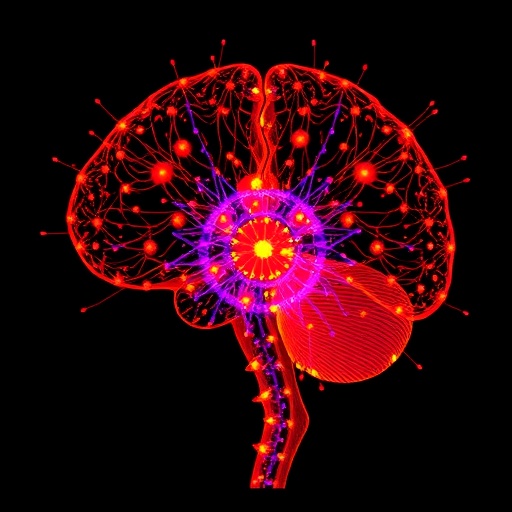A groundbreaking study from the University of Pittsburgh reveals a novel therapeutic avenue for tackling proteinopathies — neurodegenerative diseases characterized by the accumulation of misfolded proteins — through modulation of nuclear speckles inside cell nuclei. Published in Nature Communications, this research propels our understanding of cellular proteostasis and opens doors to interventions for conditions such as Alzheimer’s, Parkinson’s, and prion diseases, which have long eluded effective treatments.
At the heart of this innovative research lies the cellular structure known as the nuclear speckle, a membraneless organelle residing within the nucleus. These speckles are critical regulators of gene expression, orchestrating the production, folding, and degradation of proteins — a delicate balance called proteostasis. Lead investigator Bokai Zhu, Ph.D., assistant professor in the Department of Medicine and the Aging Institute at the University of Pittsburgh, highlights the newfound importance of nuclear speckles in neurodegeneration. “Our work indicates that the dysregulation of nuclear speckles plays a pivotal role in neuronal decline across various proteinopathies,” Zhu explains. This paradigm-shifting insight positions nuclear speckle modulation as an exciting target for therapeutic development.
Previous investigations by Zhu’s lab had uncovered that the morphology of nuclear speckles, particularly their sphericity, correlates with functional capacity. Speckles adopting a more spherical shape exhibited impaired proteostasis, whereas irregular shapes were associated with healthier protein handling. Armed with this observation, Zhu’s team hypothesized that pharmacological agents capable of altering speckle geometry towards less rounded configurations might restore proteostasis and mitigate pathological protein accumulation.
.adsslot_m9CWwyQd3H{ width:728px !important; height:90px !important; }
@media (max-width:1199px) { .adsslot_m9CWwyQd3H{ width:468px !important; height:60px !important; } }
@media (max-width:767px) { .adsslot_m9CWwyQd3H{ width:320px !important; height:50px !important; } }
ADVERTISEMENT
To test this hypothesis, the researchers embarked on an extensive screening of FDA-approved drugs, aiming to identify compounds that modify nuclear speckle sphericity. Remarkably, pyrvinium pamoate emerged as a potent candidate. Originally developed as an antihelminthic agent targeting pinworms, pyrvinium pamoate demonstrated a unique capacity to reduce nuclear speckle roundness and subsequently enhance cellular proteostasis. William Dion, Ph.D., a former graduate student and first author, recounts the excitement surrounding these findings: “Our data confirmed that modifying nuclear speckle shape with pyrvinium pamoate directly restored proteostasis in cellular models, validating our initial hypothesis.”
Building upon promising in vitro results, the team collaborated extensively with experts in tauopathies, notably Dr. Xu Chen at UC San Diego. Tauopathies are neurodegenerative disorders marked by the accumulation of misfolded tau protein, which leads to cognitive and motor impairments. In primary mouse neurons engineered to express human tau protein, treatment with pyrvinium pamoate resulted in approximately a 70% reduction in pathological tau levels — a striking outcome given the notoriously stubborn nature of tau aggregates. Zhu reflects, “The magnitude of tau clearance in these neurons was unexpected and underscored the potential of nuclear speckle modulation in disease-relevant models.”
Further work by graduate student Yuren Tao investigated human neurons harboring mutations linked to frontotemporal dementia, a devastating neurodegenerative condition. These mutated neurons exhibited abnormally shaped nuclear speckles and elevated tau accumulation. Administering low doses of pyrvinium pamoate successfully reinstated the irregular, functional speckle morphology, simultaneously driving a significant decrease in tau pathology. Importantly, these therapeutic effects were achieved without detectable cellular stress or toxicity, highlighting the drug’s safety profile in neuronal contexts.
To unravel the mechanistic underpinnings of pyrvinium pamoate’s action, the team employed advanced biophysical techniques, including optical tweezers that manipulate microscopic structures with laser precision. Conventional nuclear speckles exhibit high surface tension, maintaining their spherical form and mechanical rigidity. Treatment with pyrvinium pamoate markedly decreased the surface tension of nuclear speckles, rendering them malleable and capable of stretching and rupture. This biophysical alteration leads to a less spherical and more broadly distributed speckle structure within the nucleus.
Such morphological transformation has profound functional consequences. As Zhu explains, “Reducing the surface tension of nuclear speckles enhances their contact with chromatin, thereby facilitating transcriptional activation of genes involved in proteostasis.” Unlike traditional drugs that target discrete receptor proteins, pyrvinium pamoate exerts a global epigenetic influence by modulating the physical properties of nuclear organelles. This mechanism enables the coordinated upregulation of hundreds of proteostasis-regulating genes, which may account for its effectiveness in clearing diverse misfolded proteins.
The implications of this discovery are far-reaching. By targeting a previously underappreciated cellular structure and exploiting its biophysical properties, the study introduces an entirely new class of neuroprotective strategies. Zhu is optimistic about the clinical potential: “We are eager to advance this paradigm to human trials and assess whether rehabilitating nuclear speckles can translate into meaningful therapeutic benefits for patients suffering from devastating proteinopathies.”
In addition to the core research team led by Zhu and Chen, the study benefited from the contributions of scientists across multiple disciplines, including pharmacology, ophthalmology, and molecular neuroscience. This collaborative effort underscores the multifaceted nature of neurodegenerative disease research and the importance of integrated approaches in developing innovative therapies.
As the field moves forward, this work stands as a compelling testament to the power of re-envisioning fundamental cellular structures as therapeutic targets. The notion of “nuclear speckle rehabilitation” may soon become a central theme in neurodegenerative disease research, inspiring novel drug design strategies that harness biophysical modulation to restore neuronal health.
Subject of Research: Nuclear speckles and their role in proteostasis regulation to ameliorate proteinopathies
Article Title: SON-dependent nuclear speckle rehabilitation alleviates proteinopathies
Web References:
https://www.nature.com/articles/s41467-025-62242-7
http://dx.doi.org/10.1038/s41467-025-62242-7
Image Credits: Zhu lab
Keywords:
Cell biology, Cellular physiology, Nuclear localization, Molecular biology, Neuroscience, Cellular neuroscience, Molecular neuroscience, Alzheimer disease, Neurodegenerative diseases, Parkinsons disease, Neurological disorders, Diseases and disorders, Health and medicine
Tags: Alzheimer’s disease researchBokai Zhu researchcellular proteostasis mechanismsgene expression regulationneurodegenerative disease treatmentnovel treatments for misfolded proteinsnuclear speckle modulationParkinson’s disease therapiesprion disease interventionsproteinopathies and neurodegenerationtherapeutic development in neuroscienceUniversity of Pittsburgh study





